Non-Contact Adaptive Voltage Sensor Based on Electric Field Coupling Principle
Abstract
:1. Introduction
2. Sensor Measuring Principle
2.1. Principles of Electric Field Coupling Measurement
2.2. Adaptive Principle of Voltage Sensors
3. Voltage Sensor System Design
3.1. Voltage Sensor Structure Design
3.2. Design of Back-End Signal Processing Circuit
4. Experimental Testing and Result Analysis
4.1. Low-Voltage (400 V) Performance Test
4.2. High-Voltage (10 kV) Performance Test
5. Conclusions
Author Contributions
Funding
Data Availability Statement
Conflicts of Interest
References
- Khawaja, A.H.; Huang, Q.; Khan, Z.H. Monitoring of Overhead Transmission Lines: A Review from the Perspective of Contactless Technologies. Sens. Imaging 2017, 18, 24. [Google Scholar]
- Yang, P.; Wen, X.; Lv, Y.; Chu, Z.; Peng, C. A non-intrusive voltage measurement scheme based on MEMS electric field sensors: Theoretical analysis and experimental verification of AC power lines. Rev. Sci. Instrum. 2021, 92, 065002. [Google Scholar] [CrossRef] [PubMed]
- Shenil, P.S.; George, B. Development of a Nonintrusive True-RMS AC Voltage Measurement Probe. IEEE Trans. Instrum. Meas. 2019, 68, 3899–3906. [Google Scholar] [CrossRef]
- Reza, M.; Rahman, H.A. Non-Invasive Voltage Measurement Technique for Low Voltage AC Lines. In Proceedings of the 2021 IEEE 4th International Conference on Electronics Technology (ICET), Chengdu, China, 7–10 May 2021; IEEE: Piscataway, NJ, USA, 2021; pp. 143–148. [Google Scholar]
- Tajdinian, M.; Allahbakhshi, M.; Biswal, S.; Malik, O.P.; Behi, D. Study of the impact of switching transient over voltages on ferroresonance of CCVT in series and shunt compensated power systems. IEEE Trans. Ind. Inform. 2020, 16, 5032–5041. [Google Scholar] [CrossRef]
- Quach, N.T.; Chae, S.H.; Song, S.H.; Kim, E.H. Frequency and voltage control strategies of the Jeju island power system based on MMC-HVDC systems. J. Power Electron. 2018, 18, 204–211. [Google Scholar]
- Yoshida, H.; Kawata, K.; Fukuyama, Y.; Takayama, S.; Nakanishi, Y. A particle swarm optimization for reactive power and voltage control considering voltage security assessment. IEEE Trans. Power Syst. 2000, 15, 1232–1239. [Google Scholar] [CrossRef]
- Bi, T.; Shen, R.; Plans, J.; Zhao, H. A novel method for single phase-to-ground fault location based on wavelet analysis and correlation. In Proceedings of the Innovative Smart Grid Technologies (ISGT), Washington, DC, USA, 24–27 February 2013; IEEE: Piscataway, NJ, USA, 2013; pp. 1–4. [Google Scholar]
- Barker, P.P.; Mancao, R.T.; Kvaltine, D.J.; Parrish, D.E. Characteristics of lightning surges measured at metal oxide distribution arresters. IEEE Trans. Power Deliv. 1993, 8, 301–310. [Google Scholar] [CrossRef]
- Sadeghkhani, I.; Ketabi, A.; Feuillet, R. Artificial-intelligence-based techniques to evaluate switching over voltages during power system restoration. Adv. Artif. Intell. 2013, 2013, 316985. [Google Scholar] [CrossRef]
- Liu, G.Y.; Kang, L.; Peng, W.N. On-Line Monitoring System for Transformer Partial Discharge. Appl. Mech. Mater. 2013, 303, 464–467. [Google Scholar] [CrossRef]
- Yang, Q.; Dong, H.; Chen, S.Q.; Sima, W.; Yuan, T.; Han, R. Non-contact overvoltage monitoring sensor based on electro-optic effect. High Volt. Eng. 2015, 41, 140–145. [Google Scholar]
- Sima, W.; Han, R.; Yang, Q.; Sun, S.; Liu, T.; Liu, H. Contactless optical overvoltage sensor based on dual-crystal compensation. High Volt. Eng. 2018, 44, 3465–3473. [Google Scholar]
- Olguín-Becerril, M.A.; Angeles-Camacho, C.; Fuerte-Esquivel, C.R. Ferroresonance in subharmonic 3rd mode in an inductive voltage transformer, a real case analysis. Int. J. Electr. Power Energy Syst. 2014, 61, 318–325. [Google Scholar] [CrossRef]
- Radmanesh, H.; Rostami, M. Effect of circuit breaker shunt resistance on chaotic ferroresonance in voltage transformer. Adv. Electr. Comput. Eng. 2010, 10, 71–77. [Google Scholar] [CrossRef]
- Xiao, Y.; Fu, J.; Hu, B.; Li, X.; Deng, C. Problems of voltage transducer in harmonic measurement. IEEE Trans. Power Deliv. 2004, 19, 1483–1487. [Google Scholar] [CrossRef]
- Kaczkowski, A.; Knoth, W. Combined sensors for current and voltage are ready for application in GIS. CIGRE 1998, 12, 106–108. [Google Scholar]
- Edmunds, J.L.; Sonmezoglu, S.; Martens, J.; Von Meier, A.; Maharbiz, M.M. Optical voltage sensor based on a piezoelectric thin film for grid applications. Opt. Express 2021, 29, 33716–33727. [Google Scholar] [CrossRef] [PubMed]
- Shenil, P.; George, B. An auto-balancing scheme for non-contact ac voltage measurement. In Proceedings of the 2018 IEEE 9th International Workshop on Applied Measurements for Power Systems (AMPS), Bologna, Italy, 26–28 September 2018; pp. 1–5. [Google Scholar]
- Gorla, D.P.M.; Janus, P.; Edin, H. Non-contact Voltage Measurement Technique for On-Line Monitoring of Transient Overvolt-ages. In Proceedings of the Nordic Insulation Symposium, Trondheim, Norway, 13–15 June 2022; Volume 27. [Google Scholar]
- Jiang, S.; Jia, R.; Tao, K.; Wu, Y.; Liu, S. High-resistance voltage dividers fabricated by thin polysilicon films in silicon drift detectors. J. Mater. Sci. Mater. Electron. 2019, 30, 6617–6627. [Google Scholar] [CrossRef]
- Martins, A.V.; Bacurau, R.M.; dos Santos, A.D.; Ferreira, E.C. Nonintrusive energy meter for nontechnical losses identification. IEEE Trans. Instrum. Meas. 2019, 69, 1140–1147. [Google Scholar] [CrossRef]
- Villani, C.; Benatti, S.; Brunelli, D.; Benini, L. A contactless three-phase autonomous power meter. In Proceedings of the 2016 IEEE SENSORS, Orlando, FL, USA, 30 October–3 November 2016. [Google Scholar]
- Zhu, L.; Mo, W.; Wang, Y.; Fan, W.; Li, G.; Huang, B. Investigation of Wide Band Voltage Measurement Technology for Switching Transient Overvoltage Induced by the Operation of the Vacuum Circuit Breaker. In Proceedings of the 2019 IEEE Sustainable Power and Energy Conference (iSPEC), Beijing, China, 21–23 November 2019. [Google Scholar]
- Metwally, I.A. D-dot probe for fast-front high-voltage measurement. IEEE Trans. Instrum. Meas. 2010, 59, 2211–2219. [Google Scholar] [CrossRef]
- Metwally, I.A. Comparative measurement of surge arrester residual voltages by D-dot probes and dividers. Electr. Power Syst. Res. 2011, 81, 1274–1282. [Google Scholar] [CrossRef]
- Chen, X.; Chen, J.; Mu, X.; Zhang, Z. Single-wire power transmission based on spatial electric field coupling: Simulation, understanding and construction. Proc. CSEE 2017, 37, 5749–5758+5852. (In Chinese) [Google Scholar]
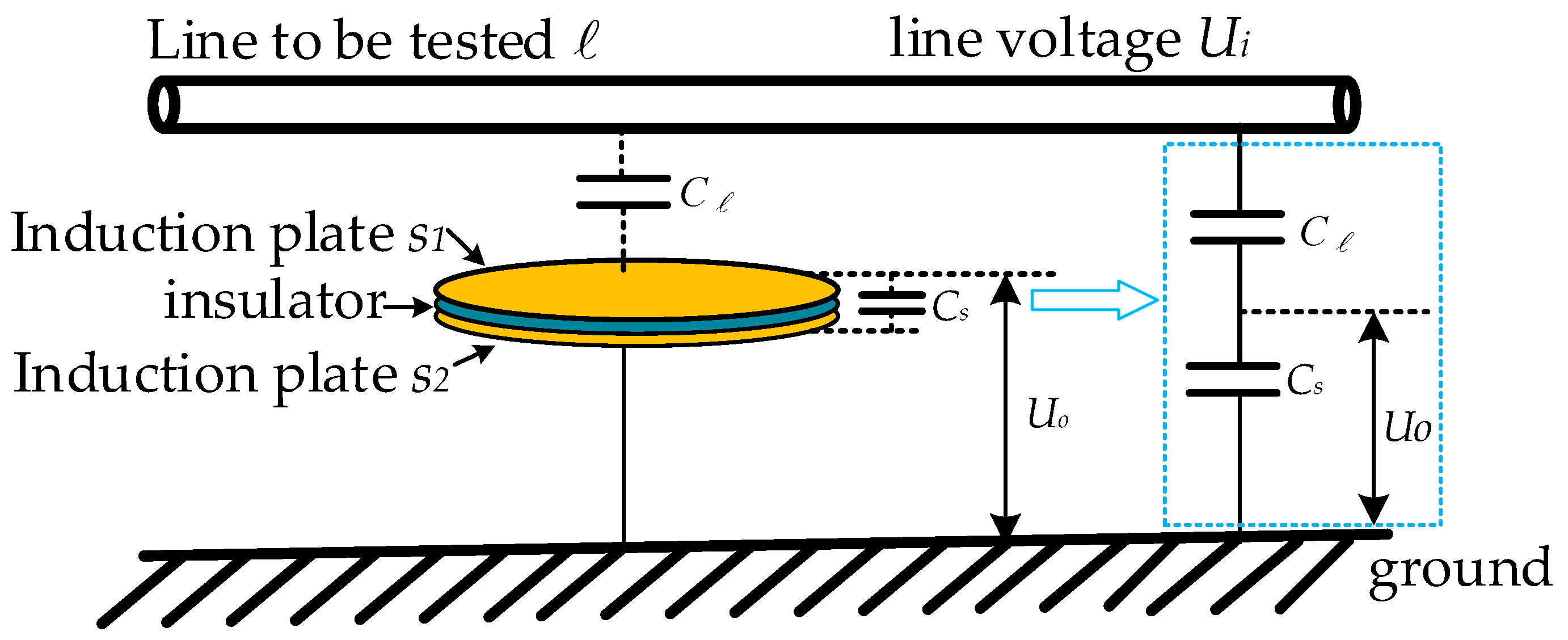
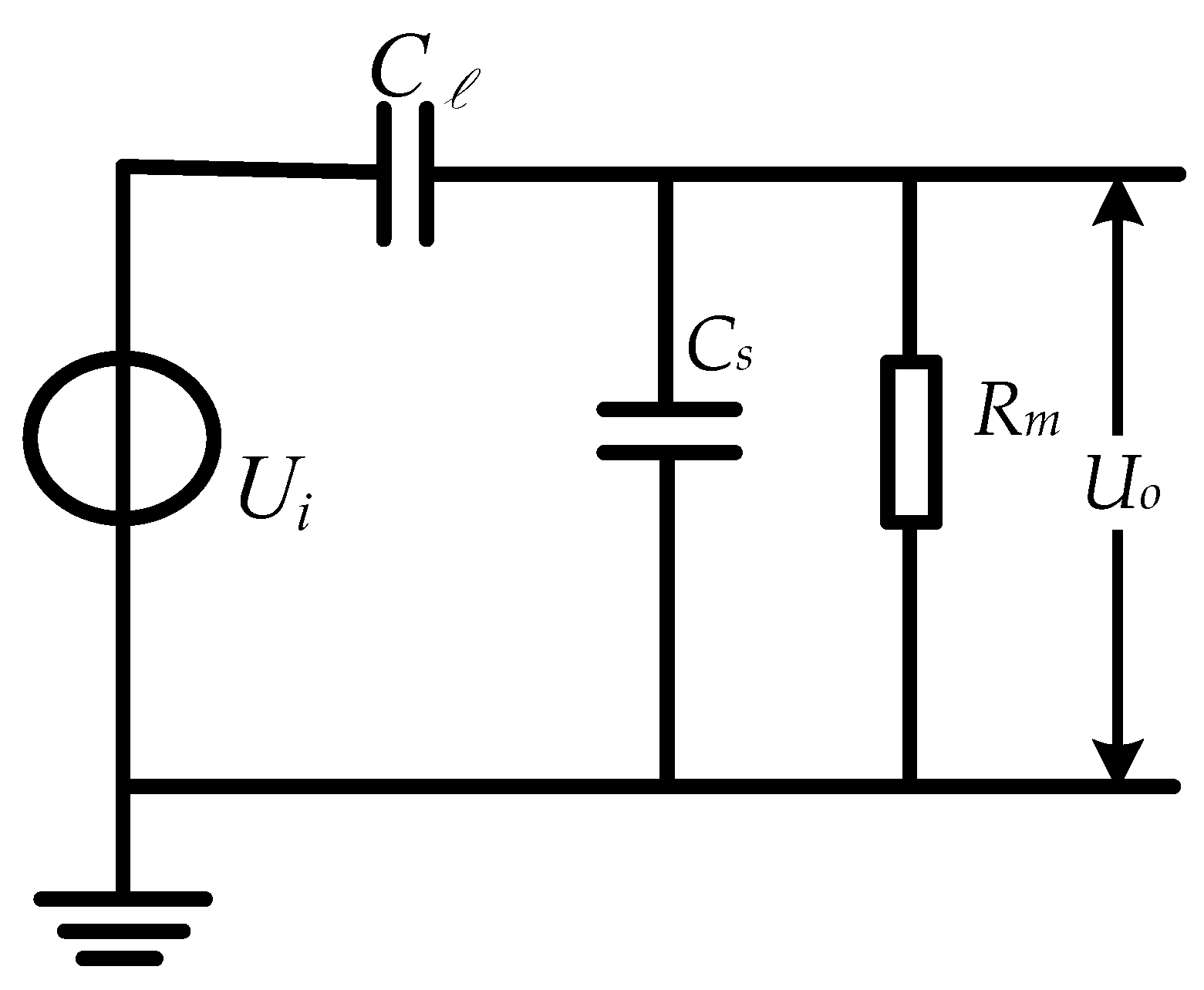
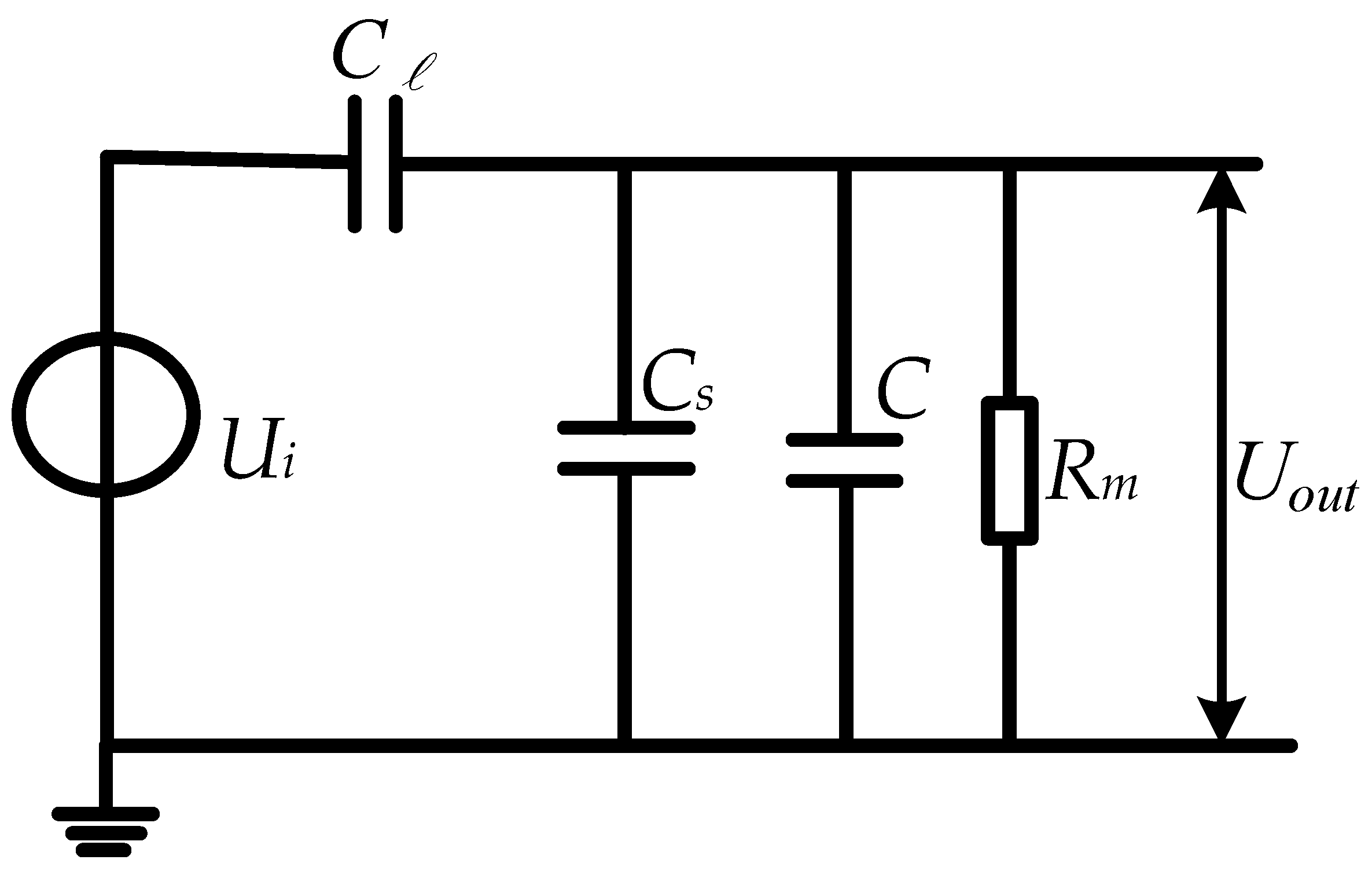
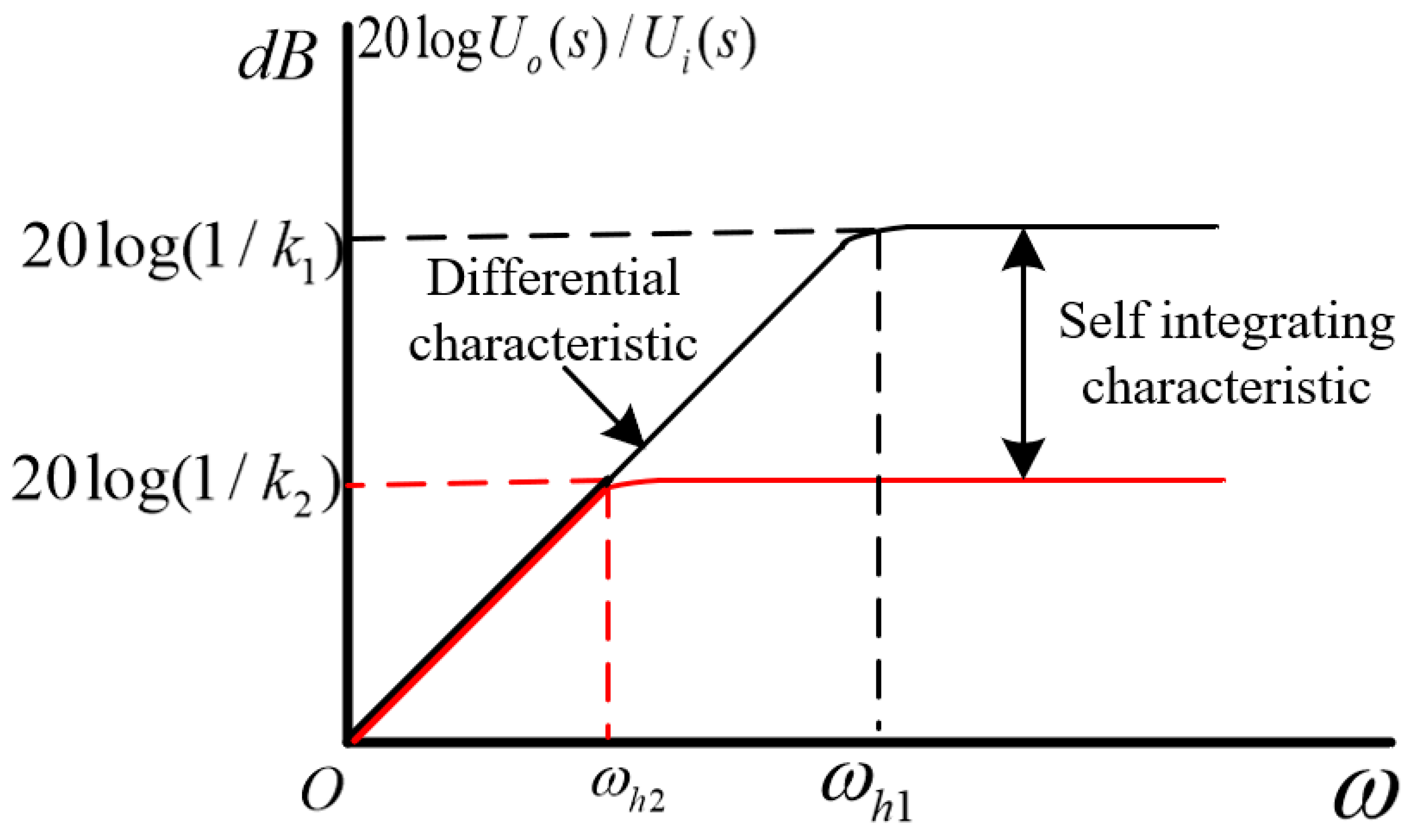


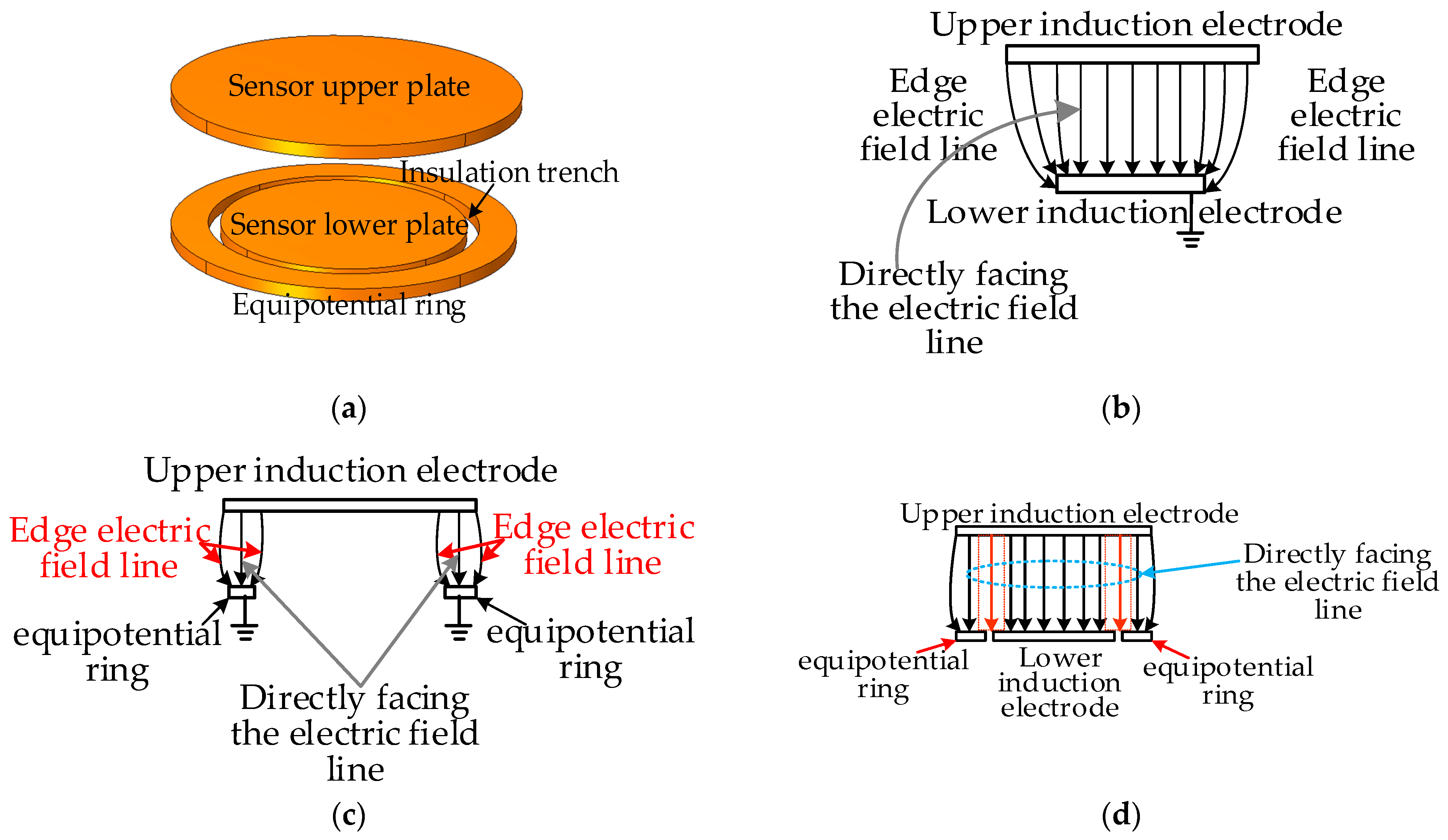





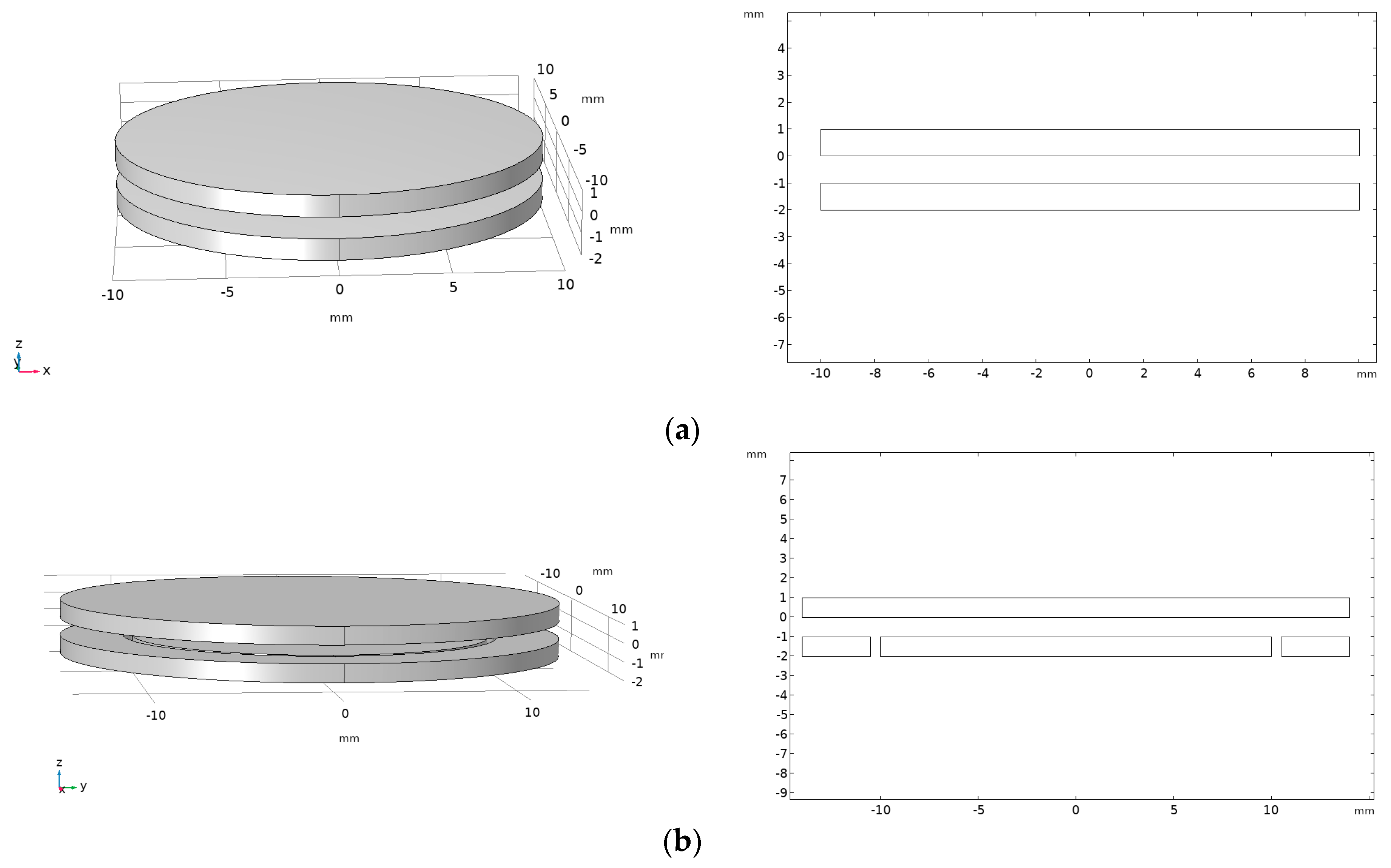

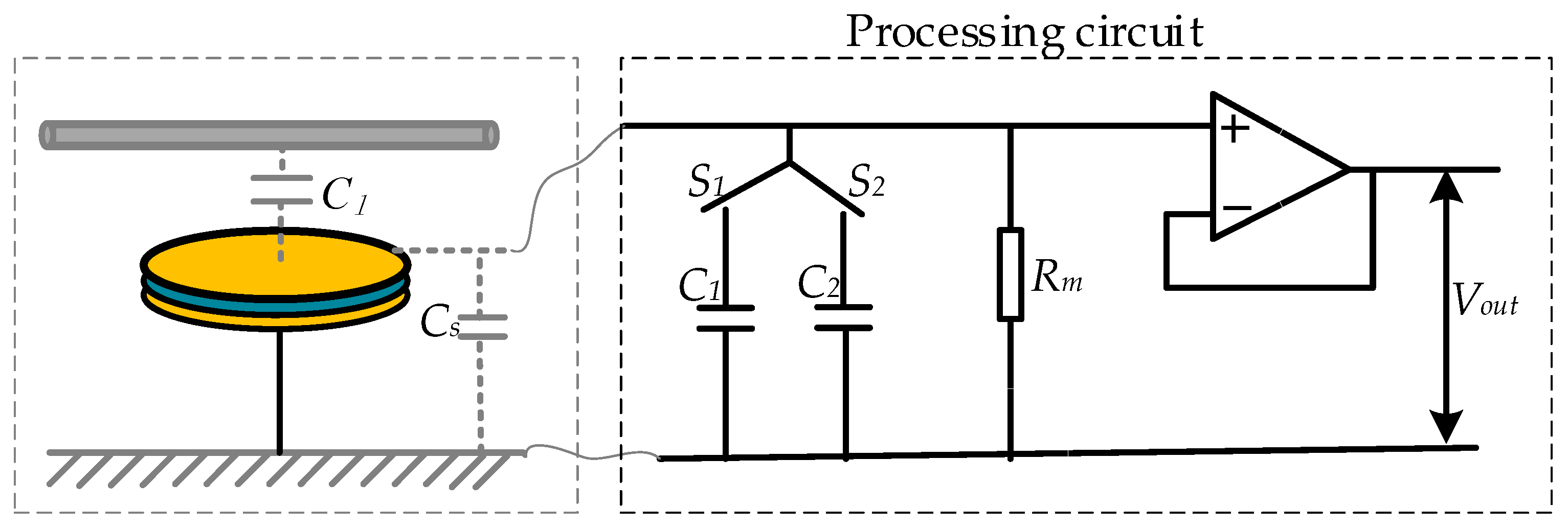
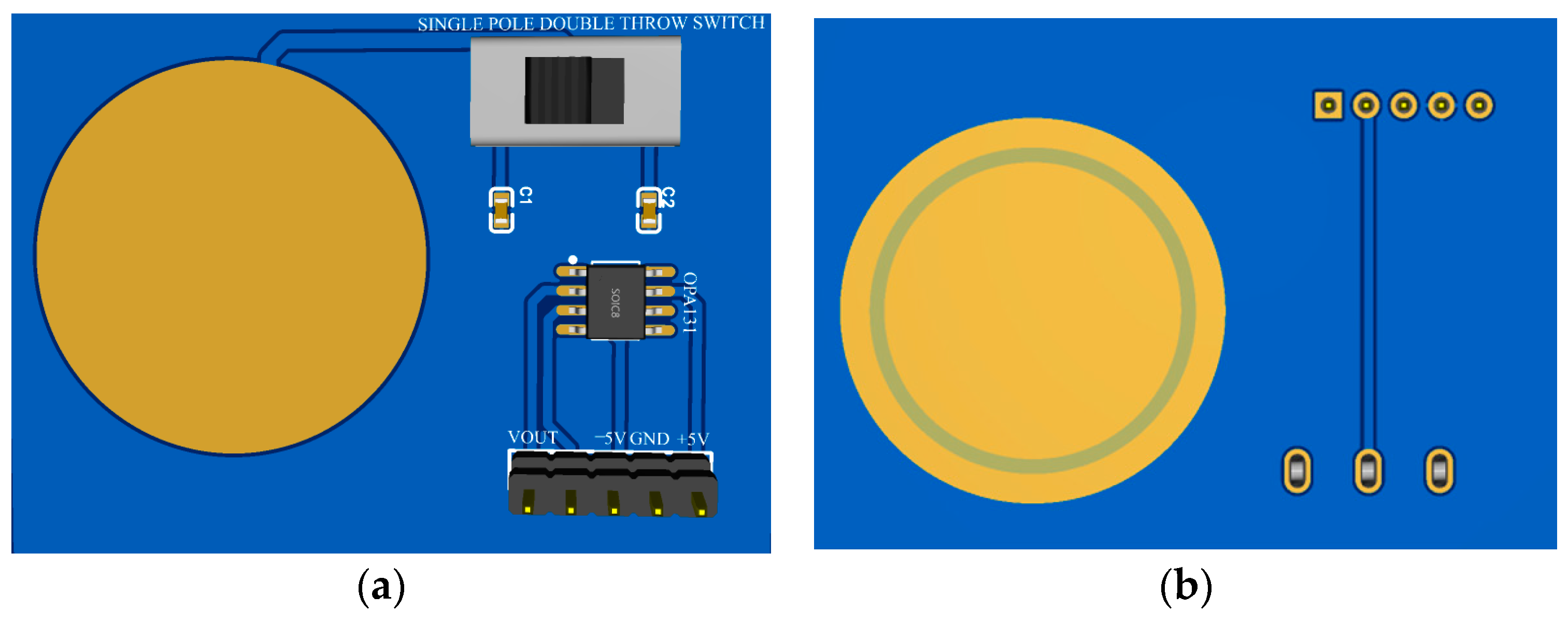

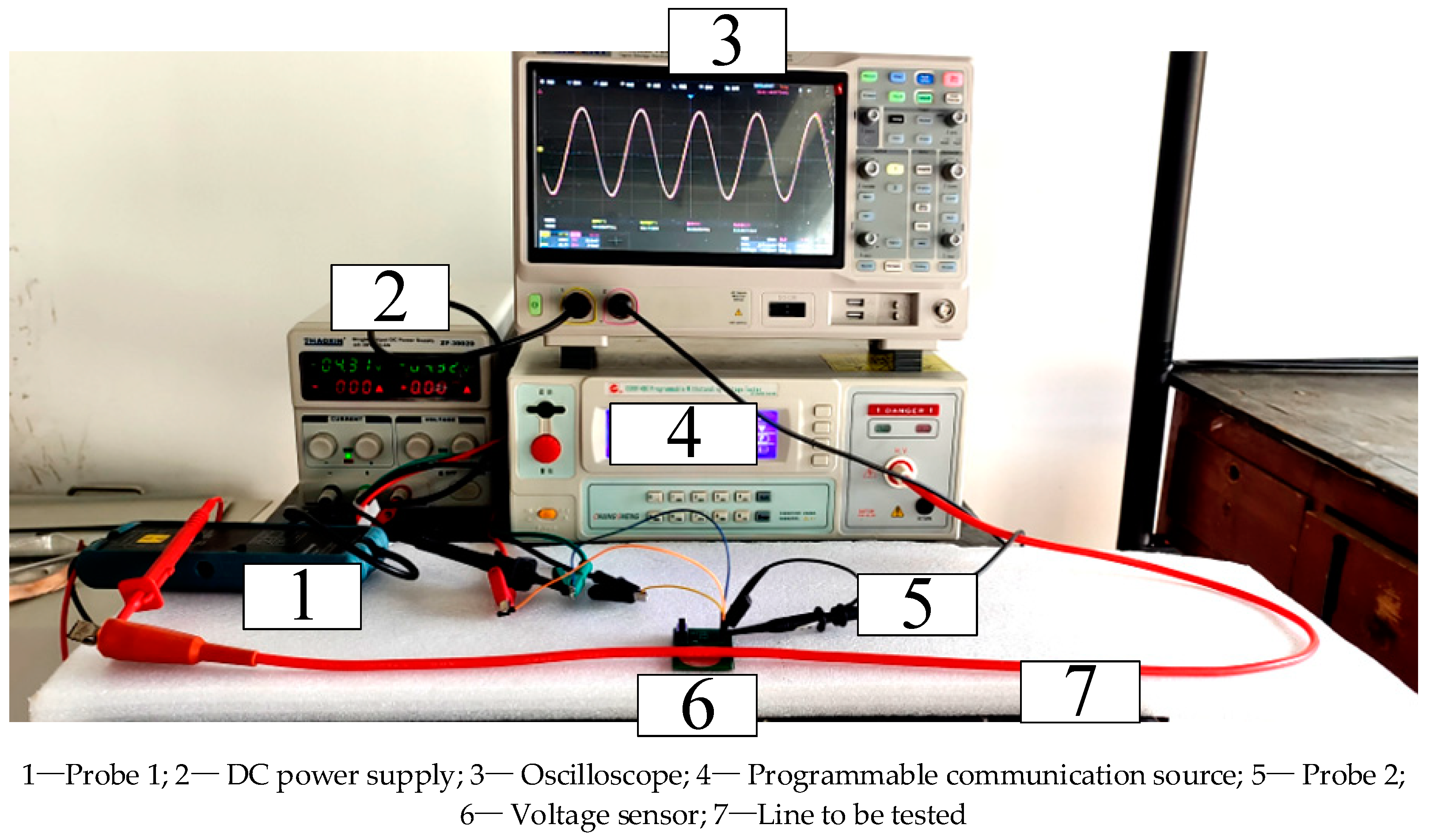




| Insulation Trench Width d [mm] | Average Value of Electric Field Mode Line | % |
|---|---|---|
| 0.5 | 1000.1 | 0.01 |
| 1 | 1000.2 | 0.02 |
| 1.5 | 1000.4 | 0.04 |
| 2 | 1002.8 | 0.28 |
| 2.5 | 1004.1 | 0.41 |
| 3 | 1003.5 | 0.35 |
| 3.5 | 1005.8 | 0.58 |
| 4 | 1017.5 | 1.75 |
| 4.5 | 1018.6 | 1.86 |
| Sensor Structure Type | Capacitance Value (pF) | Percentage Deviation from Theoretical Value (%) |
|---|---|---|
| No equipotential ring structure | 3.3270 | 19.8% |
| Adding an equipotential ring | 2.8684 | 3.12% |
| Line Voltage to Be Tested Ui (V) | Sensor Output Voltage Uo (mV) | Voltage Division Ratio | % |
|---|---|---|---|
| 104.21 | 99.86 | 1044 | 1.13 |
| 121.69 | 115.74 | 1051 | 0.38 |
| 142.43 | 134.21 | 1061 | −0.55 |
| 161.65 | 152.25 | 1062 | −0.60 |
| 181.81 | 171.37 | 1061 | −0.52 |
| 203.70 | 195.26 | 1043 | 1.16 |
| 222.45 | 209.56 | 1061 | −0.58 |
| 241.87 | 233.12 | 1038 | 1.72 |
| 262.56 | 249.11 | 1054 | 0.13 |
| 285.97 | 274.19 | 1043 | 1.19 |
| 306.13 | 295.07 | 1037 | 1.73 |
| 328.55 | 312.21 | 1052 | 0.29 |
| 343.76 | 324.85 | 1058 | −0.27 |
| 368.51 | 352.05 | 1047 | 0.82 |
| 383.09 | 364.12 | 1052 | 0.31 |
| 405.01 | 379.01 | 1069 | −1.24 |
| Line Voltage to Be Tested Ui (kV) | Sensor Output Voltage Uo (V) | Voltage Division Ratio | % |
|---|---|---|---|
| 0.481 | 0.116 | 4147 | 1.33 |
| 0.941 | 0.229 | 4109 | 2.25 |
| 1.571 | 0.378 | 4156 | 1.09 |
| 2.024 | 0.489 | 4139 | 1.51 |
| 2.507 | 0.609 | 4117 | 2.06 |
| 3.063 | 0.731 | 4190 | 0.27 |
| 3.454 | 0.816 | 4233 | −0.74 |
| 3.952 | 0.961 | 4112 | 2.17 |
| 4.516 | 1.076 | 4197 | 0.11 |
| 5.041 | 1.210 | 4166 | 0.85 |
| 5.512 | 1.329 | 4147 | 1.30 |
| 6.120 | 1.481 | 4132 | 1.67 |
| 6.549 | 1.572 | 4166 | 0.85 |
| 6.985 | 1.639 | 4262 | −1.41 |
| 7.469 | 1.785 | 4184 | 0.41 |
| 7.995 | 1.921 | 4162 | 0.95 |
| 8.465 | 2.024 | 4182 | 0.46 |
| 8.958 | 2.142 | 4182 | 0.46 |
| 9.468 | 2.264 | 4182 | 0.47 |
| 9.989 | 2.366 | 4222 | −0.48 |
Disclaimer/Publisher’s Note: The statements, opinions and data contained in all publications are solely those of the individual author(s) and contributor(s) and not of MDPI and/or the editor(s). MDPI and/or the editor(s) disclaim responsibility for any injury to people or property resulting from any ideas, methods, instructions or products referred to in the content. |
© 2023 by the authors. Licensee MDPI, Basel, Switzerland. This article is an open access article distributed under the terms and conditions of the Creative Commons Attribution (CC BY) license (https://creativecommons.org/licenses/by/4.0/).
Share and Cite
Tan, X.; Zhang, W.; He, M.; Li, W.; Ao, G.; Zhou, F. Non-Contact Adaptive Voltage Sensor Based on Electric Field Coupling Principle. Sensors 2023, 23, 8316. https://doi.org/10.3390/s23198316
Tan X, Zhang W, He M, Li W, Ao G, Zhou F. Non-Contact Adaptive Voltage Sensor Based on Electric Field Coupling Principle. Sensors. 2023; 23(19):8316. https://doi.org/10.3390/s23198316
Chicago/Turabian StyleTan, Xiangyu, Wenbin Zhang, Mingxing He, Wenyun Li, Gang Ao, and Fangrong Zhou. 2023. "Non-Contact Adaptive Voltage Sensor Based on Electric Field Coupling Principle" Sensors 23, no. 19: 8316. https://doi.org/10.3390/s23198316





